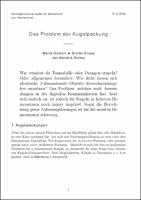| dc.contributor.author | Dostert, Maria | |
| dc.contributor.author | Krupp, Stefan | |
| dc.contributor.author | Rolfes, Jan Hendrik | |
| dc.contributor.editor | Firsching, Moritz | |
| dc.contributor.editor | Cederbaum, Carla | |
| dc.date.accessioned | 2016-04-01T11:45:13Z | |
| dc.date.available | 2016-04-01T11:45:13Z | |
| dc.date.issued | 2016 | |
| dc.identifier.uri | http://publications.mfo.de/handle/mfo/459 | |
| dc.description.abstract | Wie würdest du Tennisbälle oder Orangen stapeln? Oder allgemeiner formuliert: Wie dicht lassen sich identische 3-dimensionale Objekte überschneidungsfrei anordnen? Das Problem, welches auch Anwendungen in der digitalen Kommunikation hat, hört sich einfach an, ist jedoch für Kugeln in höheren Dimensionen noch immer ungelöst. Sogar die Berechnung guter Näherungslösungen ist für die meisten Dimensionen schwierig. | de_DE |
| dc.language.iso | de_DE | en_US |
| dc.publisher | Mathematisches Forschungsinstitut Oberwolfach | en_US |
| dc.relation.ispartofseries | Snapshots of modern mathematics from Oberwolfach; 2016,04 | |
| dc.rights | Attribution-ShareAlike 4.0 International | * |
| dc.rights.uri | http://creativecommons.org/licenses/by-sa/4.0/ | * |
| dc.title | Das Problem der Kugelpackung | de_DE |
| dc.type | Article | en_US |
| dc.identifier.doi | 10.14760/SNAP-2016-004-DE | |
| local.series.id | SNAP-2016-004-DE | |
| local.subject.snapshot | Algebra and Number Theory | |
| local.subject.snapshot | Discrete Mathematics and Foundations | |
| local.subject.snapshot | Geometry and Topology | |
| dc.identifier.urn | urn:nbn:de:101:1-2016042130522 | |
| dc.identifier.ppn | 1656073021 | |


